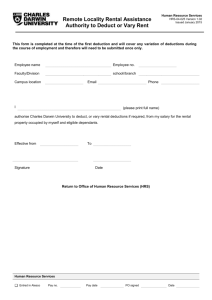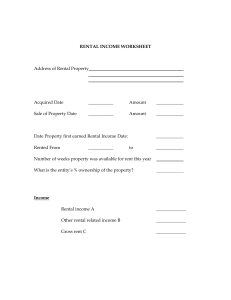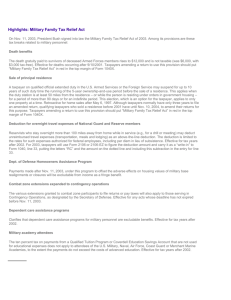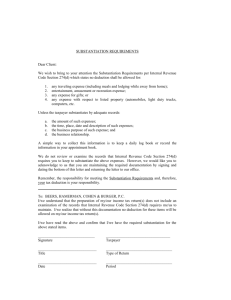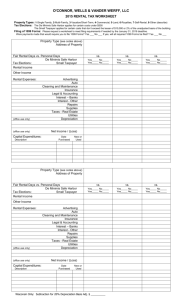Chapter 14 - McGraw Hill Higher Education - McGraw
advertisement
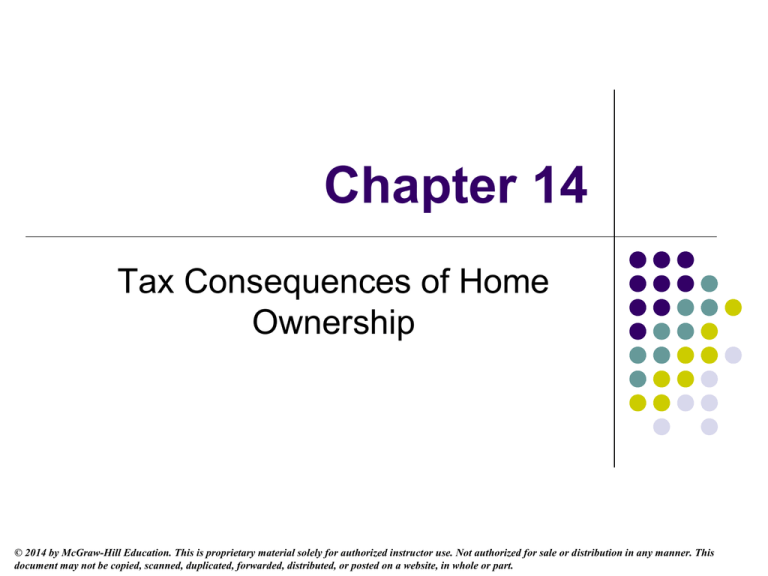
Chapter 14 Tax Consequences of Home Ownership © 2014 by McGraw-Hill Education. This is proprietary material solely for authorized instructor use. Not authorized for sale or distribution in any manner. This document may not be copied, scanned, duplicated, forwarded, distributed, or posted on a website, in whole or part. Learning Objectives 1. 2. 3. 4. 5. 6. Determine whether a home is considered a principal residence, a residence (not principal), or a nonresidence for tax purposes. Compute the taxable gain on the sale of a residence and explain the requirements for excluding the gain on the sale. Determine the amount of allowable interest expense deductions on loans secured by a residence Discuss the deductibility of real property taxes and describe the first-time home buyer credit Explain the tax issues and consequences associated with rental use of the home, including determining the deductibility of residential rental real estate losses Describe the requirements necessary to qualify for home office deductions and compute the deduction limitations on home office deductions 14-2 Tax Status of Dwelling Unit Dwelling unit includes Home Condominium Mobile boat Other similar property Dwelling unit may be used for Solely personal use Mixture of personal use and rental use Solely rental use 14-3 Tax Status of Dwelling Unit Whether dwelling unit is residence or nonresidence for tax purposes depends on how unit is used Dwelling unit is residence if Personal use days is more than the greater of 14 days or 10 percent of the number of rental days during the year Otherwise it is a nonresidence for tax purposes 14-4 Tax Status of Dwelling Unit Personal use days include Days taxpayer (owner) or other owner stays in home Days a relative of owner stays in home even if relative pays fair market value (unless home is relative’s principal residence) Days a nonowner stays in home under vacation hoe exchange or swap Days a taxpayer rents out property for less than fmv 14-5 Tax Status of Dwelling Unit Rental days include Days when taxpayer rents property at fmv Days spent repairing or maintaining home for rental use Days home is available for rent but not rented out are not personal or rental days 14-6 Tax Status of Dwelling Unit Residence is “principal” residence Subjective determination Taxpayer can have only one principal residence for a year May change from year to year 14-7 Tax Status of Dwelling Unit For a given year, for tax purposes a dwelling unit may be Principal residence Residence (not principal), or Nonresidence (rental property) 14-8 Tax Provisions by Property Type 14-9 Tax and Nontax Considerations Nontax consequences of Home Ownership Large investment Potential for big return (or loss) on investment with use of leverage Risk of default on home loan Time and costs of maintenance Limited mobility Tax consequences of Home Ownership Interest expense deductible Gain on sale excludable Real property taxes on home deductible Rental and business use possibilities 14-10 Sale of Personal Residence Typically, gain or loss recognized on sale of personal residence is capital gain or loss. Because a personal residence is a “personaluse asset” any loss recognized is not deductible. Part or all of the gain might be excluded if taxpayer meets certain requirements 14-11 Exclusion Maximum exclusion $500,000 for married filing jointly taxpayers $250,000 for other taxpayers Gain in excess of exclusion Generally taxed as long-term capital gains Subject to preferential rates Must meet ownership and use tests to qualify for exclusion 14-12 Ownership Test The taxpayer must have owned the property for a total of two or more years during the five-year period ending on the date of sale If married taxpayers, either spouse can satisfy this requirement This requirement is meant to prevent a taxpayer from buying a home, fixing it up, and soon thereafter selling it and excluding the gain. 14-13 Use Test The taxpayer must have used the property as the taxpayer’s principal residence for a total of two or more years during the five-year period ending on the date of sale. If married, both spouses must satisfy this requirement. This requirement is meant to ensure that taxpayers are selling homes they actually lived in instead of investment property. 14-14 Exceptions to general exclusion rules Nonqualified use limitation Applies if taxpayer has nonqualified use of home on or after January 1, 2009. Nonqualified use includes time the home is not the taxpayer’s principal residence. Nonqualified use period does not include any portion of the five year period ending on the date of sale that is after the last date the property was used as principal residence by taxpayer or taxpayer’s spouse. Amount of realized gain eligible for exclusion is reduced based on ratio of nonqualified use divided by the period of time the taxpayer owned the home. Hardship circumstances If taxpayer required to sell before ownership/use requirements met because of unusual circumstances, exclusion is still available but maximum exclusion is reduced. $500,000 (mfj) or $250,000 (other taxpayers) x months taxpayer meets the ownership/use requirements /24 months) 14-15 Amount of Exclusion in Hardship Circumstances 7 Taxpayers may choose to use the number of days the taxpayer fully qualified for the exclusion divided by 730 days. 14-16 Exclusion of Gain on Sale of Personal Residence Exclusion of gain from debt forgiveness on foreclosure of home mortgage Applies through December 31, 2013 May exclude up to $2 million of debt forgiveness 14-17 Interest Expense Deduction Taxpayers allowed to deduct “qualified residence interest” “Qualified residence interest” includes interest paid on: Acquisition indebtedness Home equity indebtedness The loan(s) must be secured by a “qualified residence” 14-18 Limitations on Interest Expense Deduction Tax law limits the amount of debt upon which interest can be deducted Acquisition indebtedness: $1,000,000 Home-equity indebtedness: $100,000 If loans exceed the limitations, can use either: Average method Chronological order 14-19 Other Qualified Residence Interest Mortgage insurance premiums paid during 2013 are treated as qualified residence interest Applies to mortgage insurance contracts issued since January 1, 2007. Deduction phases out between $100,000 and $110,000 of AGI. Phases out between $100,000 and $110,000 AGI ($50,000 and $55,000 AGI if married filing separately) 14-20 Points Usually a home buyer arranging financing pays “points” Each point is 1% of the principal amount Points paid for specific services (appraisal fees or notary fees) are not tax deductible Points paid to reduce the interest rate (discount points) and points paid for loan origination fees are generally deductible. 14-21 Points Discount points paid on refinancing a home loan are generally not immediately deductible by the homeowner. Must be amortized and deducted over life of loan. 14-22 Real Property Taxes Owners of real property generally have to pay property taxes. Generally taxpayers pay their property taxes through escrow A holding account with the lender and each monthly payment includes approximately 1/12th of the property taxes. The taxpayer gets a deduction when the property taxes are actually paid to the jurisdiction. When property is sold during the year, the buyer and seller deduct the taxes for the portion of the year that they owned the property. 14-23 First-time Home Buyer Tax Credit Potentially available for home purchases from April 9, 2008 – April 30, 2010. Different rules apply depending on timing of purchase If claimed credit for home purchase in 2008 Maximum credit of $7,500 Must pay back over 15 years beginning with 2010 tax return 1/15th (6.67% a year for 15 years) If sell home stop using home as principal residence must pay balance of credit in that year 14-24 First-time Home Buyer Tax Credit If received credit for purchases from January 1, 2009 through April 30, 2010 Generally not required to pay credit back Must pay back if sell home or stop using it as principal residence within 36 months of purchase 14-25 Rental Use of Home Three types of classifications for second home: Residence with minimal rental use (rents for 14 or fewer days) Residence with significant rental use (rents home for 15 or more days) Nonresidence Recall definition of residence from beginning of chapter 14-26 Residence with Minimal Rental Use The taxpayer must live in the home for at least 15 days and rent it out for 14 days or less Rental income can be excluded No rental expenses except those that are personal itemized deductions (home mortgage interest and real estate taxes) 14-27 Residence with Significant Rental Use (Vacation home) Rent home for 15 days or more Personal use, greater of 15 days More than 10% of the total FMV rented days. Include rental revenues in gross income and allocate expenses between personal use and rental use. 14-28 Residence with Significant Rental Use Expense Allocation Expenses allocated to personal use are not deductible unless deductible under other provisions (generally mortgage interest and real estate taxes) Expenses to acquire tenants deductible in full Expenses allocated to rental use deductible only to the extent of gross rental income after deducting expenses to acquire tenants (generally no losses for a vacation home) Expenses must be deducted in a specific order. 14-29 Residence with Significant Rental Use Expense Allocation Three categories or “tiers” of expenses: Tier 1: expenses that are deductible without regard to rental activity (interest/real estate taxes/expenses to acquire tenants) Tier 2: all other expenses except for depreciation Tier 3: depreciation Generally expenses allocated based on # of days used for each activity/total days used. Exception for tier 1 expenses which can be allocated based on total days in the year instead of days used (called the “Tax Court” or “Bolton” method) 14-30 Nonresidence (Rental Property) The taxpayer includes all income and deducts all rental expenses. However, if the property is used for even a day of personal use the expenses must be allocated. Taxpayer not allowed to deduct the personal use portion of tier 1 interest expenses because the property doesn’t qualify as a residence. Personal use portion of tier 1 real property taxes are deductible as an (from AGI) itemized deduction 14-31 Losses on Rental Property Losses on rental property are generally considered to be passive activity losses (PALs) PALs can only be deducted to the extent the taxpayer has passive activity income (net rental income is passive income) $25,000 rental real estate exception May deduct as ordinary non passive loss Must be active participant in rental activity $25K amount phased out 50 cents for every dollar of AGI in excess of $100,000 (phased-out completely at AGI of $150,000) 14-32 Rental Real Estate Exception Example Solution Answer: They could deduct the entire $12,939 loss. The $25,000 exception amount would be reduced by a $10,000 phase-out [50 cents × ($120,000 - $100,000)]. The maximum amount of the rental loss that can offset ordinary income would therefore be reduced from $25,000 to $15,000 ($25,000 - $10,000 phased out). However, because their loss is less than $15,000, they may deduct the entire $12,939 rental loss against their other sources of income in year 1. 14-33 Business Use of The Home: Home Office Expense Deduction To qualify for a “home office” deduction, a taxpayer must use her home or part of her home exclusively and regularly as either: The principal place of business for any of the taxpayer’s trade/business A place to meet with patients/clients in the normal course of business 14-34 Home Office Expense Deduction If employee, deducted as unreimbursed employee business expense If self-employed, deducted for AGI but deduction limited to business income before the deduction Actual expense method Simplified method 14-35 Home Office Expense Deduction: Actual Expense Method Must allocate actual expenses between personal and business use of home Direct vs. indirect expenses Indirect expenses allocated based on square footage 14-36 Home Office Expense Deduction: Actual Expense Method Deduction is limited to gross income derived from business use of home (Schedule C net income minus business expenses unrelated to use of home). Deduct using same tier 1 – 3 sequence used for vacation homes Depreciation expense Reduces basis in home Gain on sale due to depreciation is ineligible for exclusion Gain is taxed at a maximum 25 percent rate as unrecaptured §1250 gain 14-37 Home Office Expense Deduction: Simplified Method Deduct square footage (limited to 300 square feet) x $5 per square foot application rate Maximum deduction is $1,500 no matter how large the office or how much the expense Limited to Schedule C net income minus business expenses unrelated to the home No depreciation expense. Excess expenses do not carry over Can choose each year whether to use simplified or actual expense method 14-38

